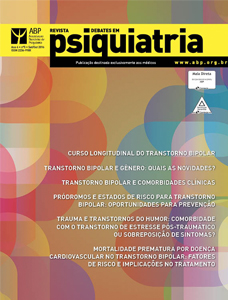Transtorno bipolar e comorbidades clínicas
DOI:
https://doi.org/10.25118/2236-918X-6-5-3Palabras clave:
Transtorno bipolar, comorbidades clínicas, monitorização do tratamentoResumen
O transtorno bipolar é associado a diversas condições médicas gerais, resultando em um aumento significativo da morbimortalidade. As doenças do sistema cardiovascular e endócrino são as mais comumente associadas ao transtorno, havendo evidências significativas do efeito deletério de algumas medicações na etiologia e curso das comorbidades clínicas. Além disso, existem evidências recentes de que a própria doença bipolar, assim como os episódios recorrentes da doença, podem estar associados a uma maior incidência de doenças físicas. A avaliação do paciente bipolar deve incluir a realização de anamnese relacionada aos fatores de risco pessoais e familiares, exame clínico, solicitação de exames complementares que foram pertinentes ao quadro e monitorização dos efeitos colaterais das medicações na saúde global do paciente.
Descargas
Métricas
Citas
Fenn HH, Bauer MS, Alshuler L, Evans DR, Williford WO, Kilbourne AM, et al. Medical comorbidity and helath-related quality of life in bipolar disorder across the adult age span. J Aff ect Disord. 2005;86:47-60.
Kupfer DJ. The increasing medical burden in bipolar disorder. JAMA. 2005;293:2528-30.
Laursen TM, Munk-Olsen T, Nordentoft M, Mortensen PB. Increased Mortality among pati ents admitt ed with major psychiatric disorders: a registerbased study comparing mortality in unipolar depressive disorder, bipolar aff ecti ve disorder, schizoaff ecti ve disorder, and schizophrenia. J Clin Psychiatry. 2007;68:899-907.
Gomes FA. Comorbidades clínicas em psiquiatria. São Paulo: Atheneu; 2012.
Evans DL, Charney DS. Mood disorders and medial illness: a major public health problem. Biol Psychiatry. 2003;54:177-80.
Frye MA, Calabrese JR, Reed ML, Wagner KD, Lewis L, McNulty J, et al. Use of health care services among persons who screen positi ve for bipolar disorder. Psychiatr Serv. 2005;56:1529-33.
Guo JJ, Keck PE Jr, Li H, Jang R, Kelton CM. Treatment costs and health care uti lizati on for pati ents with bipolar disorder in a large managed care populati on. Value Health. 2008;11:416-23.
Zhao Z, Okusaga OO, Quevedo J, Soares JC, Teixeira AL. The potenti al associati on between obesity and bipolar disorder: a meta-analysis. J Aff ect Disord. 2016;202:120-3.
McElroy SL. Obesity in pati ents with severe mental illness: overview and management. J Clin Psychiatry. 2009;70:12-21.
Mansur RB, Brietzke E, McIntyre RS. Is there a “metabolic-mood syndrome”? A review of the relati onship between obesity and mood disorders. Neurosci Biobehav Rev. 2015;52:89-104.
Fagiolini A, Kupfer DJ, Houck PR, Novick DM, Frank E. Obesity as a correlate of outcome in pati ents with bipolar I disorder. Am J Psychiatry. 2003;160:112-7.
Fagiolini A, Kupfer DJ, Rucci P, Scott JA, Novick DM, Frank E. Suicide att empts and ideati on in pati ents with bipolar I disorder. J Clin Psychiatry. 2004;65:509-14.
Wang PW, Sachs GS, Zarate CA, Marangell LB, Calabrese JR, Goldberg JF, et al. Overweight and obesity in bipolar disorders. J Psychiatr Res. 2006;40:762-4.
Gomes FA, Kauer-Sant’Anna M, Magalhães PV, Jacka FN, Dodd S, Gama CS, et al. Obesity is associated with previous suicide att empts in bipolar disorder. Acta Neuropsychiatr. 2010;22:63-7.
Wildes JE, Marcus MD, Fagiolini A. Obesity in pati ents with bipolar disorder: a biopsychosocialbehavioral model. J Clin Psychiatry. 2006;67:904-15.
Calkin CV, Gardner DM, Ransom T, Alda M. The relati onship between bipolar disorder and type 2 diabetes: more than just co-morbid disorders. Ann Med. 2013;45:171-81.
Gomes FA, Almeida KM, Magalhães PV, Caetano SC, Kauer-Sant’Anna M, Lafer B, et al. Cardiovascular risk factors in outpati ents with bipolar disorder: a report from the Brazilian Research Network in Bipolar Disorder. Rev Bras Psiquiatr. 2013;35:126-30.
McIntyre RS, Konarski JZ, Misener VL, Kennedy SH. Bipolar disorder and diabetes mellitus: epidemiology, eti ology, and treatment implicati ons. Ann Clin Psychiatry. 2005;17:83-93.
Eckel RH, Grundy SM, Zimmet PZ. The metabolic syndrome. Lancet. 2005;365:1415-28.
Vancampfort D, Vansteelandt K, Correll CU, Mitchell AJ, De Herdt A, Sienaert P, et al. Metabolic syndrome and metabolic abnormaliti es in bipolar disorder: a meta-analysis of prevalence rates and moderators. Am J Psychiatry. 2013;170:265-74.
Musselman Dl, Evans DL, Nemeroff CB. The relati onship of depression to cardiovasculardisease: epidemiology, biology, and treatment. Arch Gen Psychiatry. 1998;55:580-92.
Newcomer JW. Medical risk in patients with bipolar disorder and schizophrenia. J Clin Psychiatry. 2006;67:25-30; discussion 36-42.
Tsai SY, Lee CH, Kuo CJ, Chen CC. A retrospective analysis of risk and protective factors for natural death in bipolar disorder. J Clin Psychiatry. 2005;66:1586-91.
Correll CU, Frederickson AM, Kane JM, Manu P. Metabolic syndrome and the risk of coronary heart disease in 367 patients treated with secondgeneration antipsychotic drugs. J Clin Psychiatry. 2006;67:575-83.
Mackin P, Bishop D, Watkinson H, Gallagher P, Ferrier IN. Metabolic disease and cardiovascular risk in people treated with antipsychotics in the community. Br J Psychiatry. 2007;191:23-9.
Birkenaes AB, Opjordsmoen S, Brunborg C, Engh JA, Jonsdottir H, Ringen PA, et al. The level of cardiovascular risk factors in bipolar disorder equals that of schizophrenia: a comparative study. J Clin Psychiatry. 2007;68:917-23.
Kilbourne AM, Brar JS, Drayer RA, Xu X, Post EP. Cardiovascular disease and metabolic risk factors in male patients with schizophrenia, schizoaffective disorder, and bipolar disorder. Psychosomatics. 2007;48:412-7.
McIntyre RS, Soczynska JK, Beyer JL, Woldeyohannes H, Law C, Miranda A, et al. Medical comorbidity in bipolar disorder: reprioritizing unmet needs. Curr Opin Psychiatry. 2007;20:406-16.
Chakrabarti S. Thyroid functions and bipolar affective disorder. J Thyroid Res. 2011;2011:306367.
Hayes JF, Marston L, Walters K, Geddes JR, King M, Osborn DP. Adverse renal, endocrine, hepatic, and metabolic events during maintenance mood stabilizer treatment for bipolar disorder: a population-based cohort study. PLoS Med. 2016;13:e1002058.
Ramasubbu R, Beaulieu S, Taylor VH, Schaffer A, McIntyre RS; Canadian Network for Mood and Anxiety Treatments (CANMAT) Task Force. The CANMAT task force recommendations for the management of patients with mood disorders and comorbid medical conditions: diagnostic, assessment, and treatment principles. Ann Clin Psychiatry. 2012;24:82-90.
Cradock-O’Leary J, Young AS, Yano EM, Wang M, Lee ML. Use of general medical services by VA patients with psychiatric disorders. Psychiatr Serv. 2002;53:874-8.
Kapczinski F, Vieta E, Andreazza AC, Frey BN, Gomes FA, Tramontina J, et al. Allostatic load in bipolar disorder: implications for pathophysiology and treatment. Neurosci Biobehav Rev. 2008;32:675-92.
Ng F, Mammen OK, Wilting I, Sachs GS, Ferrier IN, Cassidy F, et al. The International Society for Bipolar Disorders (ISBD) consensus guidelines for the safety monitoring of bipolar disorder treatments. Bipolar Disord. 2009;11:559-95.
Bermudes RA, Keck Jr PE, McElroy SL. Managing metabolic abnormalities in the psychiatrically ill. A clinical guide for psychiatrists. Arlington: American Psychiatric Publishing; 2007.
De Hert M, Cohen D, Bobes J, Cetkovich-Bakmas M, Leucht S, Ndetei DM, et al. Physical illness in patients with severe mental disorders. II. Barriers to care, monitoring and treatment guidelines, plus recommendations at the system and individual level. World Psychiatry. 2011;10:138-51.
Descargas
Publicado
Cómo citar
Número
Sección
Licencia

Esta obra está bajo una licencia internacional Creative Commons Atribución-NoComercial 4.0.
Debates em Psiquiatria permite que el (los) autor (es) mantenga(n) sus derechos de autor sin restricciones. Permite al (los) autor (es) conservar sus derechos de publicación sin restricciones. Los autores deben garantizar que el artículo es un trabajo original sin fabricación, fraude o plagio; no infringe ningún derecho de autor o derecho de propiedad de terceros. Los autores también deben garantizar que cada uno atendió a los requisitos de autoría conforme a la recomendación del ICMJE y entienden que, si el artículo o parte de él es fallido o fraudulento, cada autor comparte la responsabilidad.
Reconocimiento-NoComercial 4.0 internacional (CC BY-NC 4.0) - Debates em Psiquiatria es regida por la licencia CC-BY-NC
Usted es libre de:
- Compartir — copiar y redistribuir el material en cualquier medio o formato
- Adaptar — remezclar, transformar y crear a partir del material
El licenciador no puede revocar estas libertades mientras cumpla con los términos de la licencia. Bajo las condiciones siguientes:
- Reconocimiento — Debe reconocer adecuadamente la autoría, proporcionar un enlace a la licencia e indicar si se han realizado cambios<. Puede hacerlo de cualquier manera razonable, pero no de una manera que sugiera que tiene el apoyo del licenciador o lo recibe por el uso que hace.
- NoComercial — No puede utilizar el material para una finalidad comercial.
No hay restricciones adicionales — No puede aplicar términos legales o medidas tecnológicas que legalmente restrinjan realizar aquello que la licencia permite.




























